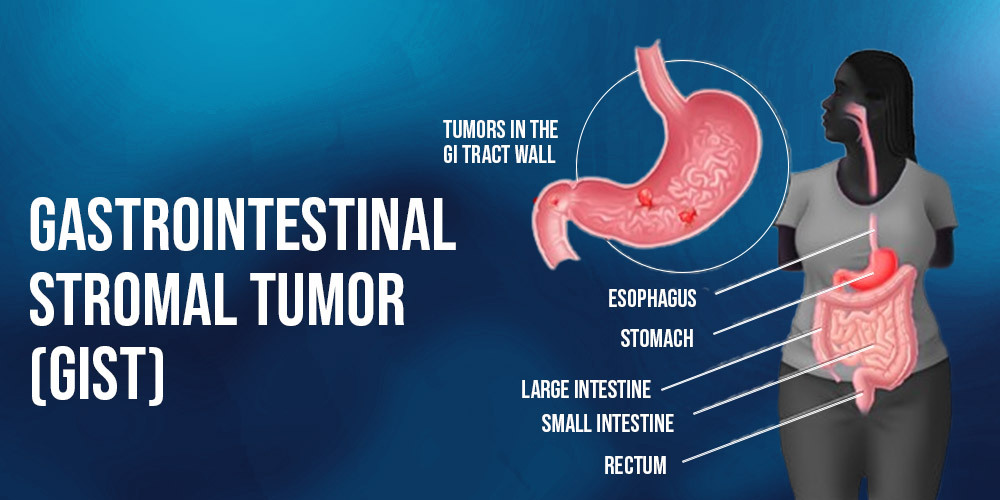
Gastrointestinal stromal tumors, commonly referred to as GIST tumors, are a rare type of cancerous growth that develops in the digestive tract. These tumors, which are part of a broader category known as rare cancerous tumors, can occur anywhere along the gastrointestinal (GI) tract but are most commonly found in the stomach.
Overall, understanding GIST tumor symptoms, diagnosis, and treatment options is crucial for patients and healthcare providers alike. Thus, in this comprehensive blog, we will explore the intricacies of gastrointestinal stromal tumors and their symptoms. Moreover, we will go over diagnostic methods, and available treatments. Last but not least, we will also be touching on the importance of participating in clinical trials of solid tumor research.
What are GIST Tumors?
GIST tumors are a type of soft tissue sarcoma that originates in the specialized cells of the gastrointestinal tract called interstitial cells of Cajal. All in all, these cells play a role in regulating the movements of the digestive system. Although GIST tumors are rare, they are the most common type of mesenchymal tumor affecting the GI tract. Moreover, they can vary in size and behavior, with some being benign and others malignant.

Common Areas of the Body Affected by GIST Tumors
- Stomach tumor: The most common site, accounting for about 60-70% of cases.
- Small intestine: Approximately 20-30% of GISTs occur here.
- Colon and rectum: Less common, but still possible locations.
- Esophagus: Rarely affected.
GIST Tumor Symptoms
In any case, recognizing GIST tumor symptoms early can lead to more effective treatment. However, symptoms can vary depending on the tumor’s size and location. Common gastrointestinal stromal tumor symptoms include:
- Abdominal pain: Often described as a dull ache or discomfort.
- Abnormal stomach growth: A noticeable lump or mass in the abdomen.
- Digestive tract lump: Can cause obstruction or bleeding.
- Nausea and vomiting: Especially if the tumor is causing a blockage.
- Blood in stool or vomit: Indicative of bleeding within the GI tract.
- Fatigue and anemia: Resulting from chronic blood loss.
It’s important to note that some GIST tumors may be asymptomatic, especially in the early stages. As a result, making regular check-ups and screenings vital.
Gastrointestinal Stromal Tumor Diagnosis
Diagnosing gastrointestinal stromal tumors involves a combination of imaging studies, endoscopic procedures, and biopsy. Therefore, early and accurate diagnosis is crucial for effective treatment.
Imaging Studies
- CT scan: Firstly, it provides detailed images of the abdomen and pelvis, helping to locate the tumor.
- MRI: Secondly it is useful for assessing the tumor’s relationship with surrounding structures.
- Endoscopic Ultrasound: Additionally, it combines endoscopy and ultrasound to visualize the tumor and guide biopsy.
Biopsy and Histopathology
Overall, a biopsy involves taking a small sample of the tumor tissue for microscopic examination. Histopathological analysis can confirm the presence of GIST tumors and provide information on the tumor’s aggressiveness.
Molecular Testing
Molecular testing can identify specific genetic mutations, such as those in the KIT or PDGFRA genes, which are common in gastrointestinal stromal tumors. This information can guide targeted therapy.
Gastrointestinal Stromal Tumors Treatment
Treatment for gastrointestinal stromal tumors typically involves a multidisciplinary approach, including surgery, targeted therapy, and sometimes radiation or chemotherapy. Moreover, the choice of treatment depends on the tumor’s size, location, and whether it has spread to other parts of the body.
Surgery
All in all, surgery is the primary treatment for localized GIST tumors. The goal is to remove the tumor entirely while preserving as much of the surrounding tissue as possible. Thus, in cases where the tumor is large or involves critical structures, neoadjuvant therapy (pre-surgical treatment) may be used to shrink the tumor.
Targeted Therapy
Targeted therapy involves drugs that specifically target the molecular abnormalities in GIST tumors. Therefore, Imatinib (Gleevec) is the most commonly used targeted therapy. Since it is effective in inhibiting the growth of tumor cells by blocking the KIT and PDGFRA proteins.
Radiation Therapy
While not commonly used for gastrointestinal stromal tumors, radiation therapy may be considered in specific cases. Hence it may be used when the tumor cannot be completely removed surgically or to relieve symptoms.
Chemotherapy
Traditional chemotherapy is generally less effective for GIST tumors compared to targeted therapy. However, it may be used in combination with other treatments in advanced cases.
Also Read: Immunotherapy vs Chemotherapy: Understanding the Difference in Cancer Treatment
Participating in Clinical Trials of Solid Tumor
Participating in clinical trials of solid tumor research can provide access to new and innovative treatments for GIST tumors. Overall, clinical trials are essential for advancing our understanding of these rare tumors and developing more effective therapies. Therefore, patients interested in participating in clinical trials of solid tumor should consult their healthcare provider to explore available options.
Living with GIST Tumors
Living with GIST tumors can be challenging, but with the right support and treatment, many patients can manage their condition effectively. Moreover, regular follow-ups, adherence to treatment plans, and lifestyle modifications can improve quality of life.
Support and Resources
- Support Groups: Connecting with others who have GIST tumors can provide emotional support and practical advice.
- Educational Resources: Staying informed about the latest research and treatment options can empower patients to make informed decisions about their care.
Lifestyle Modifications
- Healthy Diet: A balanced diet can help maintain overall health and support the immune system.
- Regular Exercise: Physical activity can improve energy levels and reduce stress.
- Stress Management: Techniques such as meditation, yoga, and counseling can help manage the emotional impact of living with a rare cancer.
Conclusion
GIST tumors, or gastrointestinal stromal tumors, are a rare but significant type of cancer that requires a comprehensive approach to diagnosis and treatment. Understanding GIST tumor symptoms, the importance of early diagnosis, and the available treatment options, including participating in clinical trials, is crucial for improving patient outcomes. By staying informed and proactive, patients and healthcare providers can work together to manage this challenging condition effectively.
For those interested in learning more about other types of tumors, such as tubular adenoma of colon, brain tumor, pancreatic cancer, bulky tumor, phyllodes tumor, or fungating breast tumor, exploring the benefits of clinical research can provide valuable insights and opportunities for advanced treatment options.
By raising awareness and supporting ongoing research, we can continue to make strides in the fight against GIST tumors and other rare cancers.
Frequently Asked Questions
How serious is a gastrointestinal stromal tumor (GIST)?
GISTs range from benign to malignant. Their seriousness depends on factors like tumor size, location, and mitotic rate. Some grow slowly, while others can spread aggressively.
How long can you live with GIST?
Survival varies: localized GISTs have a 5-year survival rate of over 90% with treatment. Advanced or metastatic GISTs may have shorter survival but can often be managed with targeted therapies like imatinib.
Can GIST be completely cured?
Yes, if detected early and surgically removed. However, advanced or metastatic GISTs may require lifelong targeted therapy to control growth and recurrence.
What is the prognosis for a neuroendocrine tumor of the stomach?
Prognosis depends on tumor type: well-differentiated tumors have a 5-year survival rate of 75-95%, while poorly differentiated types are more aggressive with poorer outcomes. Early detection and treatment improve prognosis.







